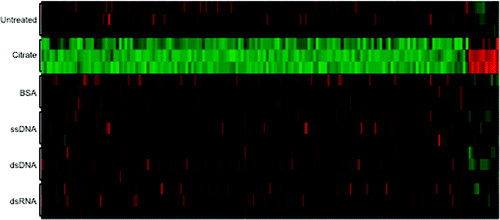Understanding How Cells Respond to Nanoparticles
November 2, 2010
Gold nanoparticles are showing real promise as vehicles for efficiently delivering therapeutic nucleic acids, such as disease-fighting genes and small interfering RNA (siRNA) molecules, to tumors. Now, a team of investigators from Northwestern University has shown that the biocompatibility and safety of gold nanoparticle-nucleic acid formulations depends significantly on how the nucleic acids and nanoparticles are linked to one another, a finding with important implications for those researchers developing such constructs.
Chad Mirkin, co-principal investigator of the Northwestern University Center for Cancer Nanotechnology Excellence, one of nine such centers established by the National Cancer Institute (NCI), led the team of investigators that studied how cells respond to different nucleic acid-nanoparticle formulations.
The key: Surface properties
To measure how cancer cells respond when they take up nanoparticles, Dr. Mirkin and his colleagues used a technique known as genome-wide expression profiling, which measures relative changes in global gene expression. The investigators added different types of nanoparticles to cancer cells growing in culture dishes and then obtained whole genome expression profiles for the cells. In all the experiments, the researchers attached non-targeting nucleic acids attached to the nanoparticles in order to minimize gene changes that might be triggered through a therapeutic effect relating to a specific, designed interaction between the nucleic acid and a targeted gene.
The results of these comparison studies showed that the surface properties of the nanoparticles had a profound impact on how a given nanoparticle impacts gene expression within a cell. The researchers observed the most surprising and noteworthy difference when they compared two nanoparticles that differed only in the manner in which the nucleic acids were attached to the nanoparticle surface. Nanoparticles loosely linked to the nucleic acids triggered large-scale changes in gene expression, while in contrast, nanoparticles linked tightly to nucleic acids through a covalent chemical bond had virtually no effect on gene expression. These findings, the researchers noted, show how important it is to fully characterize nanoparticles not only in terms of the shape and size, but also with respect to their surface properties.
This work, which is detailed in a paper titled, “Cellular Response of Polyvalent Oligonucleotide-Gold Nanoparticle Conjugates” in the journal ACS Nano, was supported in part by the NCI Alliance for Nanotechnology in Cancer, a comprehensive initiative designed to accelerate the application of nanotechnology to the prevention, diagnosis, and treatment of cancer. An abstract of this paper is available at the journal’s website.
Adapted from materials provided by the National Cancer Institute
